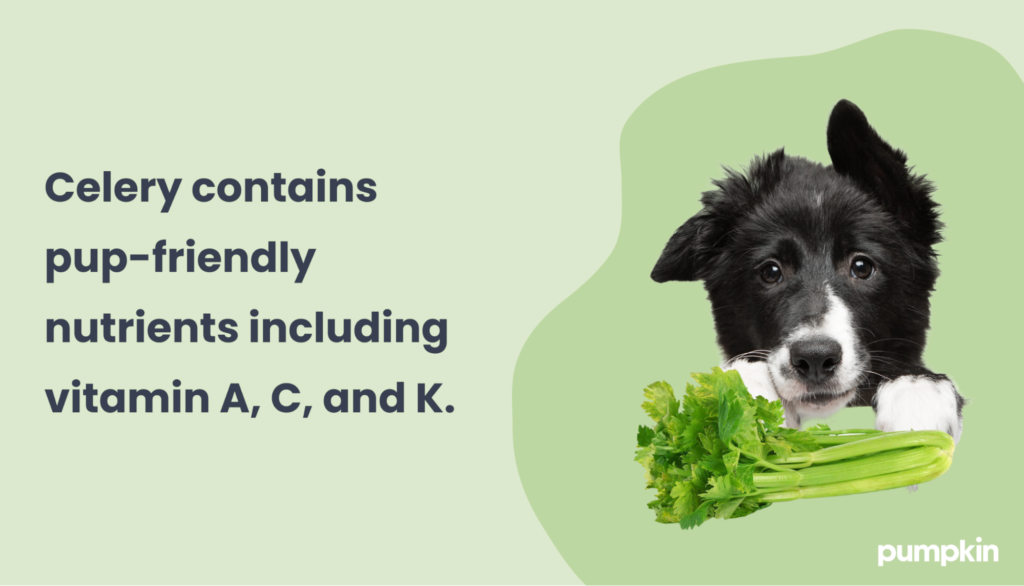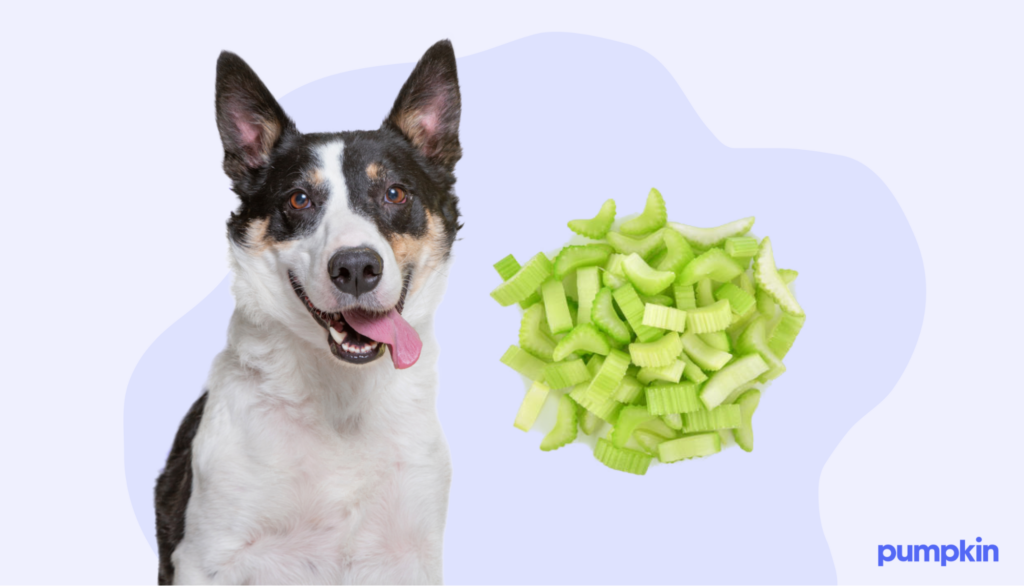Key Points:
- Yes, dogs can eat celery, but it should be chopped and served in moderation.
- Celery offers dogs vitamins A, B, and C, along with beneficial fiber.
- Some dogs may find the stringy texture of celery unappealing.
For humans, celery is a go-to for weight loss and healthy eating. But, good intentions often go out the window, and this “boring” green vegetable can end up wilting in the bottom of the fridge.
You don’t have to let it go to waste because that stalk of celery can be chopped into small pieces and served to your dog. Many pups enjoy the crunchy texture, and it’s a hydrating veggie packed with fiber and antioxidants.
But that doesn’t mean it’s right for every pup. And even though it’s a healthy snack, it’s not a replacement for a balanced diet filled with protein, fats, and carbohydrates.
Health benefits of celery for dogs
Celery is low in fat and calories and high in water and fiber. Like other water-filled fruits and veggies, it can help keep dogs hydrated during the summer months.
A celery stalk contains just 5.6 calories, making it an appropriate treat for overweight dogs. It can also replace a small amount of kibble in a regular meal, just like green beans. In fact, your vet may recommend celery as part of your pet’s weight loss plan.
This nutrient-dense, low-calorie snack is chock full of anti-inflammatory phytonutrients. Not only do celery stalks contain 95% water, no fats, and no cholesterol, but they also contain essential vitamins and nutrients such as:
- Vitamin A
- Vitamin C
- Vitamin K
- Potassium
- Magnesium
- Calcium
- Folate

Crunchy veggies like cucumbers and celery can also serve as breath fresheners. The crunchy texture and high water content stimulate saliva production to wash bacteria and plaque away.
Can puppies have celery?
Just like adult dogs, puppies can have the occasional piece of celery. However, you should wait until they’re on a solid diet, which is usually around eight weeks old.
Always chop the celery into extra-small pieces because it can cause choking or intestinal blockages. And when giving new human food to your pup for the first time, monitor them for digestive issues or signs of a bad reaction.
What are the risks of celery for dogs?
No human foods are risk-free. Here are some of the risks associated with celery and dogs:
Sodium content: Celery contains 32 mg of sodium per stalk. This is on the higher side for a vegetable, so you’ll want to limit your dog’s consumption.
Stringy fiber content: The strings of a celery stalk provide fiber but are hard to digest, which can cause your dog’s digestive tract some discomfort. They can also get stuck between your dog’s teeth, so check those chompers after sharing celery.
More frequent urination: Low levels of a diuretic in celery may make your dog pee more often. Again, moderation is key.
Stomach upset: Like anything else, celery can cause digestive issues and diarrhea if your dog eats a large amount, especially a puppy.
Pesticides: Celery leaves have the most vitamins and minerals, but they can also harbor pesticides. Celery leaves are okay to feed your dog if they’re organically grown or cleaned properly.
Choking hazard: You can reduce the risk of choking by chopping veggies into small pieces and supervising your dog while they chow down.
Being a pet owner is a rewarding journey full of firsts, but you never know when one of those firsts might lead to an accident. Learn more about how a Pumpkin pet insurance plan can help cover eligible vet bills for your pup in case of future accidents or illness.
Warning signs of a celery allergy in dogs
Some dogs can be allergic or sensitive to certain foods, including celery. Adverse reactions to this crunchy vegetable may include:
- Itchy skin
- Vomiting
- Diarrhea
- Weight loss
- Loss of energy
- Skin rash
- Sneezing
If your pup does experience any unusual symptoms, stop giving them celery until you’ve checked in with your vet.
How to serve celery to your dog
The easiest and cleanest way to offer celery to your dog is by feeding them bite-sized pieces that are plain and free from any seasonings or flavors (though a little bit of peanut butter is okay).

The right serving size depends on your dog’s weight and tolerance for the veggie, but generally, a handful of bite-sized pieces will be fine. Remember that your dog’s treats should make up only 10% of your dog’s daily calories. The other 90% should be from their regular food.
Celery alternatives for dogs
If celery isn’t something you enjoy, dogs can have other healthy human greens, too. Any of the following foods can be shared with your pup in moderation:
When you introduce a new food to your dog, always start with a small amount to see how they react.
The bottom line: Celery is good for dogs
Celery is good for humans, and it can also be good for your pet. This crunchy, low-calorie vegetable has a high water content, fiber, and other nutrients such as vitamins A, C, and K, folate, calcium, and magnesium.
Despite this, celery is a “sometimes” food, not a “three meals a day” food. It should only be served in moderation and cooked or chopped to reduce the risk of choking.
Dogs and celery: FAQs
- https://fdc.nal.usda.gov/fdc-app.html#/food-details/169988/nutrients
- https://www.sciencedirect.com/science/article/abs/pii/003193849090131M
- https://health.clevelandclinic.org/natural-diuretics
- https://www.akc.org/expert-advice/nutrition/how-many-treats-can-dog-have/
- https://pmc.ncbi.nlm.nih.gov/articles/PMC8929158/
DISCLOSURE




